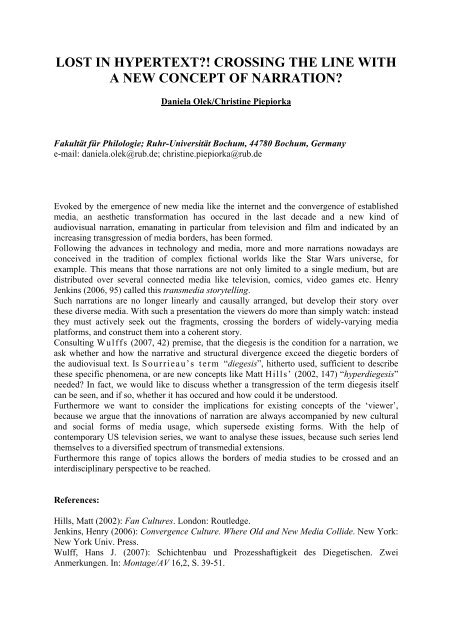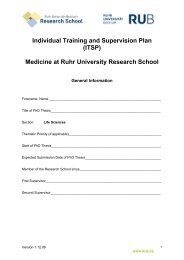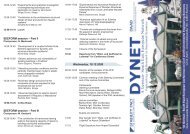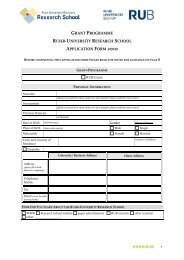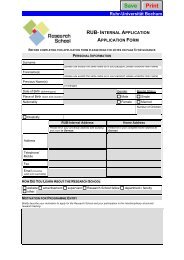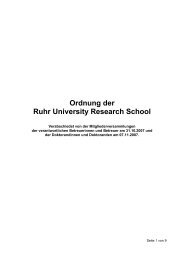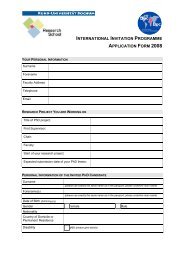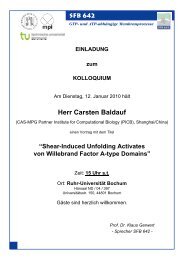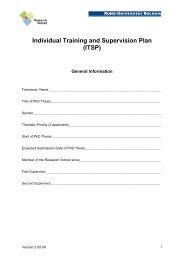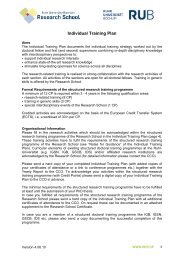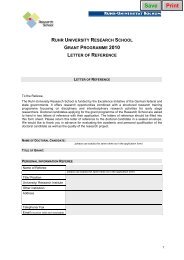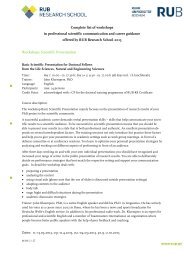Section Days abstract book 2010.indd - RUB Research School ...
Section Days abstract book 2010.indd - RUB Research School ...
Section Days abstract book 2010.indd - RUB Research School ...
Create successful ePaper yourself
Turn your PDF publications into a flip-book with our unique Google optimized e-Paper software.
LOST IN HYPERTEXT?! CROSSING THE LINE WITH<br />
A NEW CONCEPT OF NARRATION?<br />
Daniela Olek/Christine Piepiorka<br />
Fakultät für Philologie; Ruhr-Universität Bochum, 44780 Bochum, Germany<br />
e-mail: daniela.olek@rub.de; christine.piepiorka@rub.de<br />
Evoked by the emergence of new media like the internet and the convergence of established<br />
media, an aesthetic transformation has occured in the last decade and a new kind of<br />
audiovisual narration, emanating in particular from television and film and indicated by an<br />
increasing transgression of media borders, has been formed.<br />
Following the advances in technology and media, more and more narrations nowadays are<br />
conceived in the tradition of complex fictional worlds like the Star Wars universe, for<br />
example. This means that those narrations are not only limited to a single medium, but are<br />
distributed over several connected media like television, comics, video games etc. Henry<br />
Jenkins (2006, 95) called this transmedia storytelling.<br />
Such narrations are no longer linearly and causally arranged, but develop their story over<br />
these diverse media. With such a presentation the viewers do more than simply watch: instead<br />
they must actively seek out the fragments, crossing the borders of widely-varying media<br />
platforms, and construct them into a coherent story.<br />
Consulting Wulffs (2007, 42) premise, that the diegesis is the condition for a narration, we<br />
ask whether and how the narrative and structural divergence exceed the diegetic borders of<br />
the audiovisual text. Is Sourrieau’s term “diegesis”, hitherto used, sufficient to describe<br />
these specific phenomena, or are new concepts like Matt Hills’ (2002, 147) “hyperdiegesis”<br />
needed? In fact, we would like to discuss whether a transgression of the term diegesis itself<br />
can be seen, and if so, whether it has occured and how could it be understood.<br />
Furthermore we want to consider the implications for existing concepts of the ‘viewer’,<br />
because we argue that the innovations of narration are always accompanied by new cultural<br />
and social forms of media usage, which supersede existing forms. With the help of<br />
contemporary US television series, we want to analyse these issues, because such series lend<br />
themselves to a diversified spectrum of transmedial extensions.<br />
Furthermore this range of topics allows the borders of media studies to be crossed and an<br />
interdisciplinary perspective to be reached.<br />
References:<br />
Hills, Matt (2002): Fan Cultures. London: Routledge.<br />
Jenkins, Henry (2006): Convergence Culture. Where Old and New Media Collide. New York:<br />
New York Univ. Press.<br />
Wulff, Hans J. (2007): Schichtenbau und Prozesshaftigkeit des Diegetischen. Zwei<br />
Anmerkungen. In: Montage/AV 16,2, S. 39-51.


